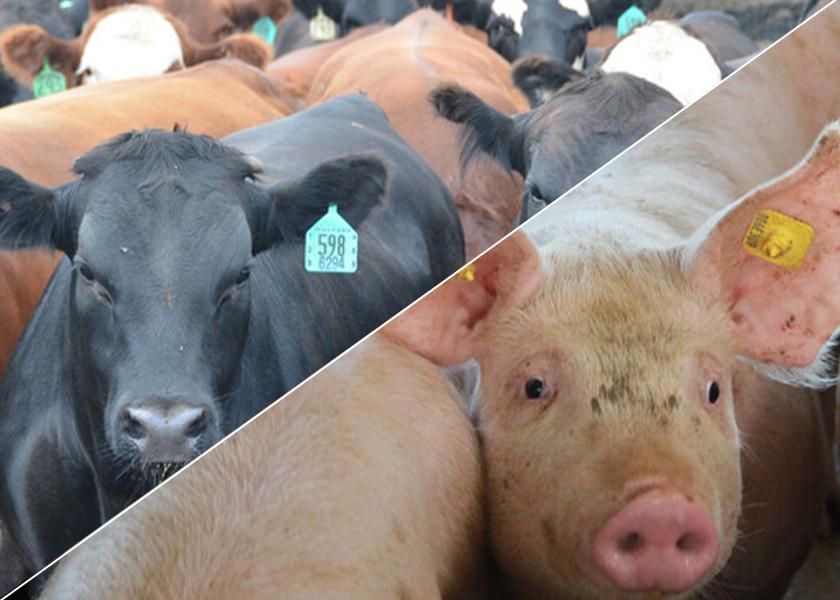Livestock Analysis | December 9, 2021

Price action: February lean hog futures surged $1.775 to $77.825, while the December contract rose $1.60 to $72.425.
Fundamental analysis: Hogs futures rose for the first day in the past five amid wholesale market strength and signs of bottoming in the CME lean hog index. After Tuesday’s official quote for the CME Lean Hog Index dipped 11 points to $70.83, yesterday’s preliminary figure rebounded 12 cents to $70.95. With the nearby contract expiring Dec. 14, the recent price action implies traders expect gains totaling approximately $1.30 over the next three days of market activity. That probably reflected yesterday’s $8.83 jump in pork cutout values. Early today, pork cutouts rose another 27 cents.
Based on historical patterns, next week’s hog slaughter will likely be the peak for 2021, followed by steady declines into early next summer. We’ll have a better handle on the 2022 supply outlook after USDA’s next Hogs and Pigs report Dec. 23. We believe reduced production will at least offset anticipated demand reductions from consumers struggling with inflated retail prices and view deferred most 2022 hog contracts as being undervalued.
Technical analysis: Yesterday’s price action seemed to establish a loosely construed head-and-shoulders bottom on the February hog futures chart. Today’s sharp rebound offered considerable reinforcement. It also gave bulls the short-term technical advantage, with clearly defined support at recent lows of $75.35, $74.625 and $74.05. A drop below the latter figure would probably open the door to a test of $70.00. Monday’s low at $78.175 looks like initial resistance, with strong backing from the 40-day moving average at $79.70. A push above that level would again have the bulls targeting the November high at $84.675.
What to do: Get current with feed advice.
Hedgers: You currently have all risk in the cash market.
Feed needs: You should have all soybean meal needs covered in the cash market through December. You are still hand-to-mouth on corn-for-feed needs.
Price action: February live cattle fell 87.5 cents to $137.80, the lowest closing price since $137.70 on Nov. 19. January feeder cattle rose 67.5 cents to $164.075, though deferred contracts ended lower.
Fundamental analysis: Live cattle futures ended near a three-week low amid indications upward momentum in the cash market is waning as high retail beef prices pinch consumer demand. Recent cash trade was relatively active around $140 in southern markets, steady with last week’s average. However, other markets reached $142 to $143 last week, suggesting the overall average this week may turn steady-to-weaker. Supplies of market-ready animals remain tight, which should limit futures downside. Choice cutout values rose 16 cents early today to $264.27, up from an eight-month low yesterday. Movement by midday was relatively strong at 130 loads, indicating that lower prices may be spurring stepped-up retailer buying. Stronger corn prices weighed on feeder futures.
USDA, in its monthly Supply and Demand update, raised estimated 2021 U.S. beef production to 27.965 billion pounds from 27.955 billion pounds, an increase of less than 0.1%, while holding exports unchanged at 3.455 billion pounds. Projected U.S. production and exports for 2022 were held unchanged at 27.07 billion pounds and 3.27 billion pounds, respectively. Also today, USDA reported net weekly U.S. beef sales at 4,200 MT, a marketing-year low and down 81% from the four-week average. That likely reflected the looming end of the calendar year. Sales for 2022 totaled 10,400 MT.
Technical analysis: Live cattle’s technical posture has gradually eroded this week, with February futures closing below the 20-day moving average for the first time since Nov. 1. The uptrend drawn from the October 1 low was also penetrated. Downside levels to watch include the 50- and 100-day moving averages, both slightly above $136.00. Other downside objectives for bears include closing February below solid support at $135.00.
What to do: Get current with feed advice. Short-term protective hedges may be needed if this week’s lows are violated.
Hedgers: Carry all risk in the cash market for now.
Feed needs: You should have all soybean meal needs covered in the cash market through December. You are still hand-to-mouth on corn-for-feed needs.






